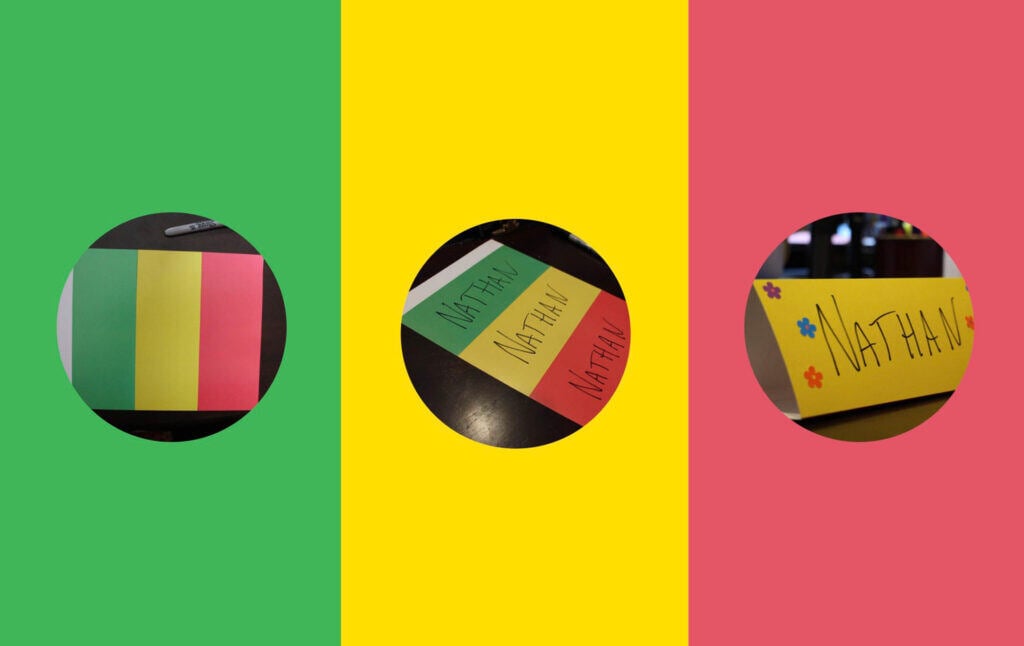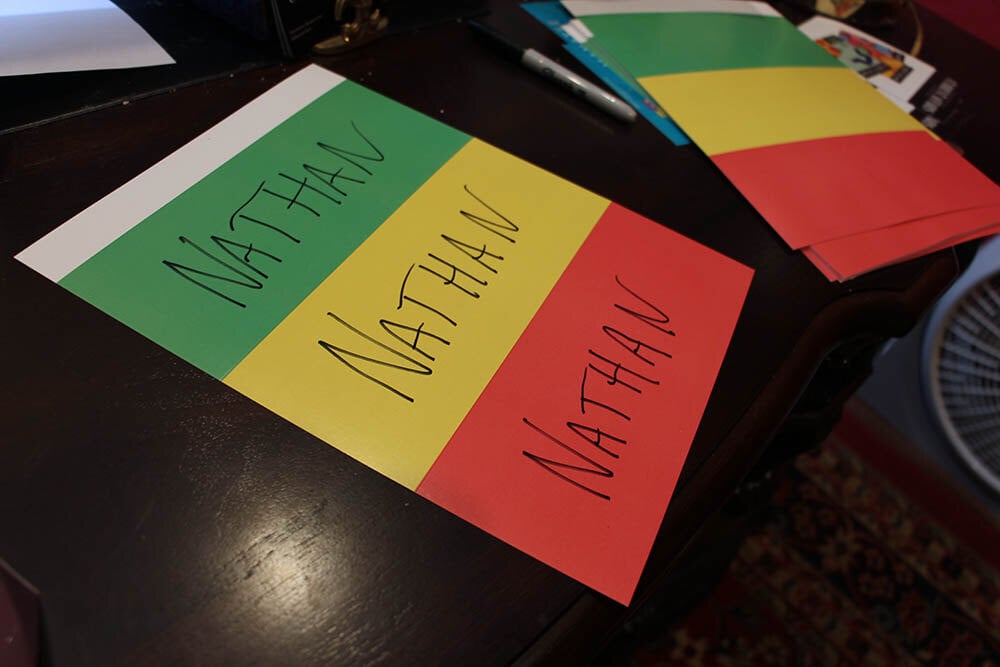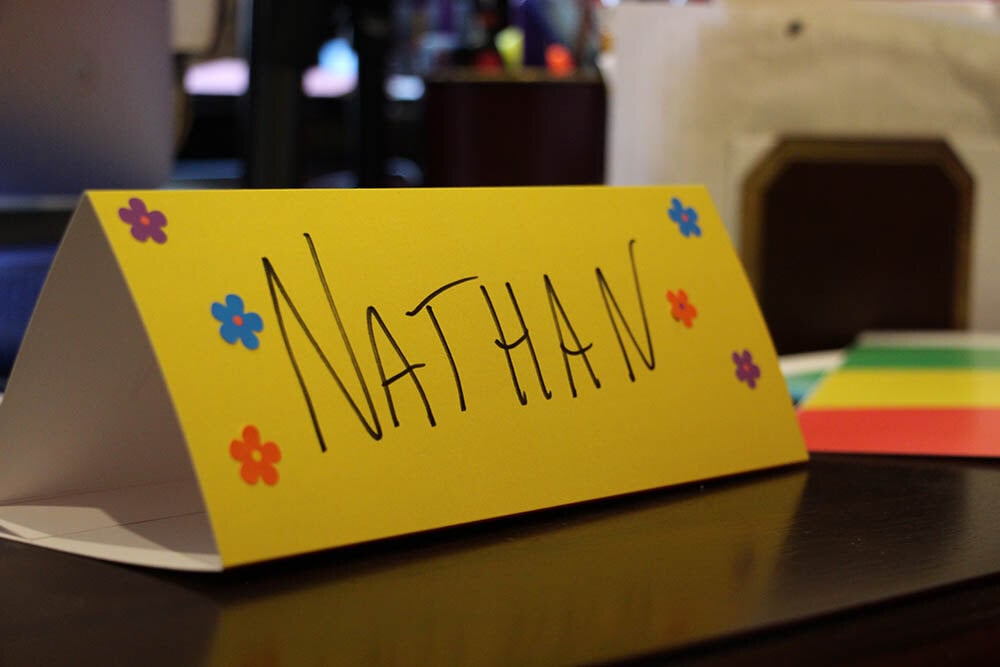
In Defense Of My Color-Coded Cold Calling Card System
A University of Chicago professor recently criticized a peculiar color-coded nametag system he saw law students using. The originator of said tri-color system would like to say a few words in its defense.
A University of Chicago law professor recently complained on Twitter (“X”) about something disturbing he’d witnessed in a classroom at Yale Law School. Every student in the class had a little tri-colored placard in front of them with their name on it, and they changed the color of their placard depending on their willingness to talk:
A student had a tri-folded cardboard name tag in front of him. No big deal, I thought, in a big class professors might need those and while I don’t use first names many of my colleagues do. Then he explained there are three colors: green for willing to talk, yellow for being on the cusp of being willing to talk, and red for not being prepared. I was stunned — the idea of a law school class where students could opt out of being called on! Judges don’t let you put up the red light when you don’t want to answer.
The professor, Adam Mortara, found the system to be a disturbing illustration of Everything That’s Wrong With The Kids On Campus These Days. It clearly showed that Yale Law School had become a kindergarten where students were being treated as “fragile”:
I can’t quite put my finger on the causation. Do law students demand to be treated like fragile children or do law faculty start treating them that way? Either way what a joke — in practice the vast majority of the class stays on yellow. This innovation will never find its way to my classroom at Chicago. But it is ok for the romper room that is Yale Law School.
Mortara’s tweet sparked an online debate among legal professionals about the value of cold-calls, which became so heated that it was reported on by Reuters.
Now, I feel I have to say a few words in defense of the strange little calling system that so disturbed Mortara.
That’s because I invented it myself.
First, a bit of background: In law school, professors have often used “cold calling” as an instructional technique. Instead of only calling on students who raise their hands, the professor will select a student at random and have them answer questions. They will be asked to recite the facts of a case, or the court’s holding, or challenged to reconcile the outcome of this case with some other previous case discussed. Or they might be asked questions about their own stance, e.g. “Should the manufacturer have to pay for the damage done to the customer when the product exploded?” and then the student will say what they think. The professor will then play Socrates, asking the student to defend their reasoning and trying to poke holes in it.
Cold-calling is somewhat infamous in law school, because some professors do it in a way that humiliates students who are either unprepared for class (by not having read the cases closely) or defend their positions poorly. The constant threat of being called on and interrogated can make a law school class very intimidating, especially if you’re shy and don’t particularly enjoy the experience of watching dozens of other people see your logic exposed as faulty.
When I was in law school, I had very mixed feelings about cold-calling. On the one hand, I thought it could be a cruel thing to do to students. On the other hand, if you don’t cold call, but you want to have a discussion rather than a lecture, you have to only call on students who volunteer. In law school, there is a subset of students known as “gunners.” They are the ones who keep their hands in the air the whole time, and if a professor doesn’t cold-call students who haven’t volunteered, the gunners will dominate the discussion.
I also think the Socratic method can be a valuable way to get students to think. Let’s say I’m a student in a media studies class, and there’s a lecture on propaganda. The professor might go through different definitions of propaganda and show examples. But it can be quite interesting for a professor to ask students: What do you think propaganda is? Do you think an advertisement is propaganda? If so, why? If not, why not? The answers might not always be logically coherent but they’re interesting.

After law school, I went to graduate school, where I became a teaching fellow and taught a weekly discussion section for a professor. I actually wanted to introduce a little bit of the “Socratic method” from law school into my discussion section, because I wanted to avoid the twin problems of (1) gunners dominating the discussion and (2) nobody raising their hands with anything to say. If you can call on any student at random, you can keep the discussion going and make sure lots more different perspectives are heard, not just the perspectives of the most eager volunteers.
Of course, there’s a problem: some people might not want to be called on at random. Because I was dealing with undergraduates, not law students, I made sure my questions were pretty non-intimidating. They weren’t attempts to expose a student’s lack of knowledge. They really were just attempts to get people thinking and talking, things like “Sophie, do you think violence in movies has a negative social effect?” or “Malik, can you offer me an example of something we might consider a ‘social norm’?” I did not try things like “Sophie, what does Foucault say on page 293 of the reading, and how do you reconcile it with Habermas’ perspective?” This would be cruel and also encourages bullshitting.
When I started out as a teaching fellow, I tried to think about how I could facilitate really good discussions, which would maximize participation without creating discomfort and intimidation. I wanted to be able to draw students into the discussion who hadn’t volunteered (maybe they’d said something in a paper that I’d like to ask them about), but I didn’t want them to think that showing up meant they always had to be ready to suddenly talk. I actually skipped a few law school classes as a student because I hadn’t made it through the cases and didn’t want to be cold-called, and I didn’t want anyone to miss my section because they weren’t feeling like talking.
So, after some thought, I came up with my color-coded name card system. I went to a print shop and had pieces of card printed with three colors: green, yellow, and red. Then I handed them out to students on the first day and asked them to turn them into namecards using a strip of double-sided tape (I also handed out stickers to decorate them with, since personally I think certain aspects of adult life should be more like kindergarten, including the greater use of stickers).


Then I told the students that they should turn their card in accordance with the following simple code:
Red – I do not wish to be called on.
Yellow – I do not mind being called on.
Green – I have something I would like to say and wish to be called on.
This meant that whenever students were on yellow, I could cold-call them if I chose, but if they weren’t feeling like being called on, they could turn their card red. I started off the first session by asking everyone to turn their card red, just to indicate that it wasn’t shameful to be on red. In practice, most of the students stayed on yellow or green. The red, the opt-out measure, was the least-used color, but students did use it, particularly some who were quite shy.
The system worked beautifully in my sections. It turns out to be quite useful for the professor to have constant real-time data on which students have something to say and the degree to which they are interested in participating. It had several advantages over normal class discussions:
- Because there was an opt-out mechanism, I was much more free to cold-call than I otherwise would have been. Cold calling is much less controversial and intimidating if it is done with a constant reaffirmation of consent to participate. Students who are having an off day can simply go red.
- People raising their hands can be annoying. They have to keep their hands up for ages sometimes, and it can be tedious for them and awkwardly conspicuous. With the system, all they do is go green. This allows them not to have to sit with their hand in the air for ten minutes. It also makes it easier for the professor to ignore the one student who volunteers for everything, since instead of having a raised hand they simply have a green card.
- Separate from the color-coding, having namecards in front of students is useful, because not only does the professor not have to worry about forgetting someone’s name, but the students don’t have to worry either. They can easily refer to each other’s points because they know everyone’s names. It’s much easier to learn everyone’s names when they are not just said once, but there constantly.
I taught two sections with this system, and I’d use it in any discussion-based class I taught in the future. The instructor has to be a little savvy about getting a feel for what students are saying with the cards. (For instance, some shy students will turn their card from red to yellow when they’d like to say something, rather than from yellow to green, and a typically-red student should be called on when they go yellow.) But it made the process of calling on people very easy, and there was never an awkward silence with no one speaking. That’s quite impressive, I think, because I remember being in many such classes as an undergrad where the professor was painfully trying to get students to volunteer to say things. The problem can easily be resolved through a combination of cold-calling and consent, which allows for random selection while eliminating the intimidation factor.
I should mention here that the system was not entirely of my own devising. When I was in law school, Professor James Forman Jr. used a namecard system, without the color codes, and that inspired my system. He used to have us turn our namecards on their ends if we wanted to speak. That worked well, but when I started teaching undergrads I wanted a way to get more real-time information from them.1

Mortara’s criticism of the system strikes me as failing to appreciate the benefits. Interestingly, he says that “No one, including me, is suggesting that students cannot privately communicate some issue with getting called on. I get those emails all the time, and for the most part respect them.” He does not see how the system he disdains eliminates this inefficient process. He won’t have to get these emails “all the time” with my color-coding system.
Most of the legal professionals who debated Mortara’s point focused on the question of whether intimidating cold-calls are essential preparation for legal practice. Many pointed out that high-stakes Socratic questioning is not actually necessary training for what many people will do in their careers. Therefore, they argued, letting students opt out is not compromising standards or letting “fragile” students be exempted from core educational requirements.
But even if we do assume it’s useful, everyone has an off day, and I think it’s valuable to tell people that off days are okay and not shameful. I do think the irony of Mortara’s attack on my system is that I introduced it so that I could cold-call more, introducing cold-calling to undergrads who wouldn’t necessarily be used to it or enjoy it. If you make students comfortable, you’re not “appeasing their fragility” or whatever. You’re creating an environment where they’ll be much more open to being challenged.
This was, in fact, another of my big takeaways from my brief time as a teaching fellow. The whole conservative stereotype about college students is that they are coddled snowflakes who can’t handle disagreement. I found this to be nonsense. I challenged my students’ ideas all the time, but I did it in a way that made it clear that I respected their intelligence, wasn’t trying to humiliate them, and wanted to understand their perspective rather than just presenting my own as correct. By recognizing that cold calling could be intimidating, and taking steps to reduce the intimidation factor, I made them more open to it. Mortara concluded that the color system was a “joke” because almost all students were almost always on yellow. This, first, fails to appreciate that the main benefit of the system is the difference between yellow and green. But also, it shows that students aren’t in fact “coddled” and opting out of cold calling. They’re just being asked for consent, which they are almost always granting.
If you think the system is silly, don’t use it in your classrooms. But I hope some others will pick it up and try it, because I found it facilitated great discussions. I’m proud of this little innovation. And frankly, I’m a little bit delighted that someone sees it as an example of the disturbing excesses of the Woke Campus.
If you want a formal name for the tri-color cards, I would refer to them as Forman-Robinson cards. “I notice a distinct absence of Forman-Robinson cards in the classrooms at this school,” you might say. “Has the lack of Forman-Robinson cards impeded class discussions? ↩




